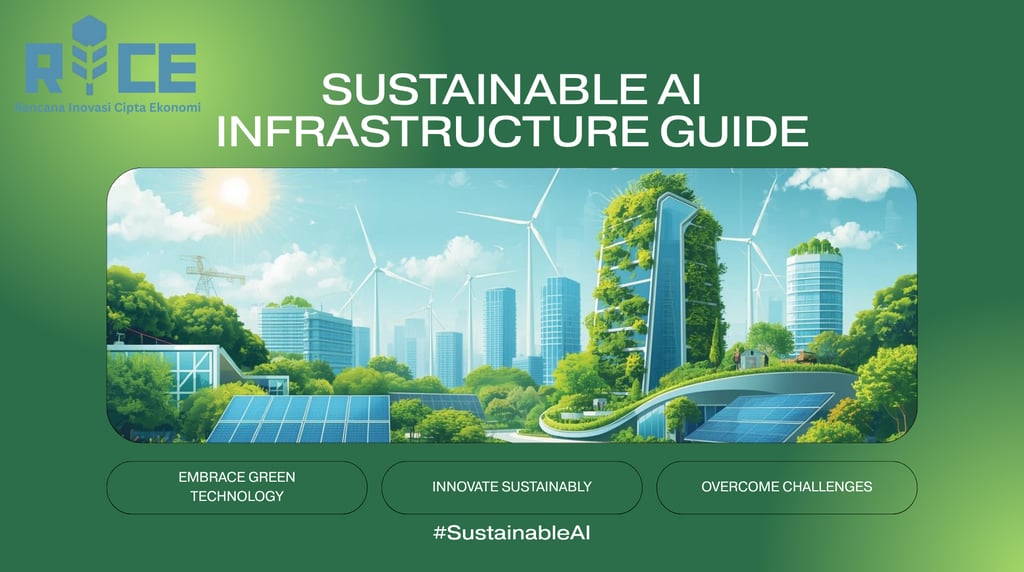Sustainable AI Infrastructure: An Expert's Guide to Overcoming Implementation Hurdles
Overcome implementation hurdles using energy-efficient hardware, optimized operations, and smart algorithms for a greener AI future.
AI INSIGHT
Rice AI (Ratna)
11/10/20259 min read


For many industry experts, the rapid ascent of Artificial Intelligence conjures images of groundbreaking innovation and transformative capabilities. Yet, beneath the surface of this technological marvel lies an increasingly complex challenge: the immense energy footprint of AI infrastructure. We face a critical juncture where the promise of AI must align with the imperative of environmental responsibility.
Imagine a future where your AI operations not only drive unprecedented business value but also actively contribute to a greener planet. This vision of sustainable AI infrastructure is no longer a distant ideal; it’s a strategic necessity. This comprehensive guide will equip you with the expert insights and actionable strategies needed to navigate the complexities of green AI implementation, transforming potential hurdles into opportunities for innovation and competitive advantage.
The Imperative for Sustainable AI
The sheer scale of modern AI, particularly with the proliferation of large language models (LLMs) and deep learning applications, has brought its environmental impact into sharp focus. Training a single sophisticated AI model can consume vast amounts of energy, comparable to the lifetime carbon emissions of several automobiles. This escalating energy demand necessitates a fundamental shift in how we design, deploy, and manage AI systems.
Current projections indicate that without intervention, the energy consumption of AI will continue its exponential growth. This trend not only strains global energy grids but also exacerbates climate change concerns. Addressing these challenges through sustainable AI infrastructure is no longer an option but a core pillar of responsible technological advancement.
Current State of AI Energy Consumption
Data centers, the physical homes of AI infrastructure, are massive energy consumers. They require substantial electricity for computing hardware, cooling systems, and auxiliary services. The continuous operation of powerful GPUs and specialized AI accelerators, coupled with intensive model training cycles, contributes significantly to global carbon emissions. Understanding these energy hotspots is the first step towards mitigation.
The lifecycle of AI hardware also plays a role in its environmental footprint. From manufacturing to disposal, the resources consumed and waste generated are considerable. This holistic view of AI's energy and material impact underscores the urgency of sustainable practices across the entire AI value chain.
Regulatory and Stakeholder Pressures
Beyond environmental ethics, a growing tide of regulatory frameworks and stakeholder expectations is compelling organizations to prioritize sustainable AI. Governments worldwide are introducing legislation focused on corporate environmental, social, and governance (ESG) factors. Compliance with these emerging standards is quickly becoming a non-negotiable aspect of doing business.
Investors are increasingly scrutinizing companies' ESG performance, viewing sustainability as a key indicator of long-term viability and risk management. Consumers also demonstrate a preference for environmentally conscious brands. Embracing green AI initiatives thus enhances corporate reputation, attracts ethical investment, and secures market trust.
Key Pillars of Sustainable AI Infrastructure
Building a truly sustainable AI infrastructure requires a multi-faceted approach, integrating efficiency and environmental responsibility at every layer. This involves strategic choices in hardware, data center operations, and even algorithmic design. Each pillar plays a crucial role in minimizing the overall carbon footprint and maximizing resource efficiency.
Achieving this balance demands a holistic perspective, moving beyond isolated optimizations to a fully integrated strategy. Companies like Rice AI are actively pioneering solutions that address these interconnected challenges, offering expertise in optimizing each component for maximum impact.
Energy-Efficient Hardware
The foundational layer of AI infrastructure is its hardware. Selecting energy-efficient components is paramount. Modern CPUs, GPUs, and specialized AI accelerators (like Google's TPUs or Nvidia's H100s) are designed with varying levels of power efficiency. Prioritizing performance-per-watt metrics during procurement is crucial.
Advanced cooling technologies, such as liquid cooling or immersion cooling, can dramatically reduce the energy required to dissipate heat in data centers. Furthermore, server virtualization and consolidation can optimize hardware utilization, ensuring that compute resources are not idly consuming power. Investing in newer generations of hardware often provides significant efficiency gains over older, less optimized equipment.
Optimized Data Center Operations
The operational efficiency of data centers is critical for sustainable AI. The Power Usage Effectiveness (PUE) metric, which measures how much energy is used by computing equipment versus overhead, is a key indicator. Striving for a PUE closer to 1.0 signifies highly efficient operations. This involves intelligent airflow management, hot/cold aisle containment, and optimizing chiller and HVAC systems.
Sourcing renewable energy for data centers is another impactful strategy. Many hyperscale cloud providers now offer services powered entirely by renewable sources. Organizations can also explore direct power purchase agreements (PPAs) for renewable energy or invest in on-site renewable generation. These steps significantly reduce the operational carbon footprint of AI infrastructure.
Algorithmic Efficiency
Sustainability isn't just about hardware; it's also about smarter software. Algorithmic efficiency focuses on developing and deploying AI models that require less computational power to achieve their objectives. Techniques like model compression (e.g., pruning, quantization, knowledge distillation) can reduce model size and inference costs without significant performance degradation.
Exploring more efficient neural network architectures and optimizing training parameters can also yield substantial energy savings. Designing 'green AI algorithms' from the ground up, with energy consumption as a key design constraint, represents a forward-thinking approach. This involves careful consideration of data preprocessing, model selection, and hyperparameter tuning to minimize computational cycles.
Overcoming Implementation Hurdles
Transitioning to sustainable AI infrastructure is rarely a straightforward path. Organizations often encounter various challenges, from initial financial outlays to integrating new technologies with existing systems. Proactive planning and a clear understanding of these hurdles are essential for successful implementation.
Addressing these obstacles requires a strategic blend of technological innovation, financial foresight, and organizational change management. Industry leaders are finding that the long-term benefits far outweigh the initial complexities, fostering more resilient and ethical AI deployments.
Initial Investment vs. Long-Term ROI
One of the most significant hurdles is the perception of high upfront costs associated with sustainable AI solutions. Investing in energy-efficient hardware, renewable energy sources, or advanced cooling systems can require substantial capital. However, it's crucial to evaluate these costs through a total cost of ownership (TCO) lens.
Sustainable infrastructure often leads to significant operational savings over time through reduced energy bills and lower maintenance. Furthermore, the enhanced brand reputation and compliance with ESG mandates can unlock new revenue streams and investment opportunities. Articulating this long-term return on investment (ROI) is key to securing executive buy-in.
Technological Complexity and Integration
Integrating new, energy-efficient hardware or sophisticated cooling systems into existing, often legacy, AI infrastructure can be technically challenging. Compatibility issues, downtime risks, and the need for specialized expertise can complicate the transition. Organizations may face skill gaps within their IT teams.
Phased implementation strategies and modular upgrades can mitigate these risks. Partnering with expert providers who specialize in sustainable AI infrastructure can also bridge technical knowledge gaps and ensure seamless integration. Careful planning and pilot projects are vital to de-risk complex deployments.
Data Management and Storage
The explosion of data, crucial for AI training, also presents a sustainability challenge. Inefficient data storage and management contribute to unnecessary energy consumption. Storing redundant or unused data on high-performance infrastructure wastes resources.
Implementing robust data lifecycle management policies is essential. This includes intelligently tiering data based on access frequency, archiving or deleting obsolete datasets, and employing data compression techniques. Opting for energy-efficient storage solutions, such as object storage with lower power requirements, can also reduce the overall data footprint.
Supply Chain Sustainability
The environmental impact of AI extends to its entire supply chain. Sourcing hardware components from manufacturers with questionable labor practices or high carbon emissions undermines sustainability efforts. Ensuring ethical and eco-friendly sourcing adds another layer of complexity.
Companies must scrutinize their vendors' environmental policies and certifications. Prioritizing hardware suppliers committed to responsible manufacturing, waste reduction, and end-of-life recycling programs contributes to a truly circular economy for AI. Transparency across the supply chain is increasingly becoming a benchmark for sustainable operations.
Strategies for a Greener AI Footprint
Moving beyond merely acknowledging the challenges, actionable strategies are required to significantly reduce AI's environmental impact. These strategies encompass leveraging cloud resources, optimizing operational workflows, investing in future technologies, and cultivating an organizational mindset centered on sustainability.
Implementing these strategies systematically will empower organizations to build robust, future-proof AI infrastructures that align with global environmental goals. It’s about building smarter, not just faster.
Adopting Cloud-Native Green Solutions
Leveraging hyperscale cloud providers (e.g., AWS, Azure, Google Cloud) can be a powerful strategy for sustainable AI. These providers typically invest heavily in renewable energy, energy-efficient data centers, and global infrastructure optimization. By migrating AI workloads to the cloud, organizations can offload the burden of managing physical infrastructure and benefit from the providers' large-scale sustainability initiatives.
Cloud platforms also offer elastic scaling, ensuring that compute resources are provisioned only when needed, reducing idle power consumption. Utilizing serverless computing options for AI inference can further minimize energy use by only charging for the exact compute resources consumed during execution. This shared responsibility model allows businesses to benefit from advanced infrastructure without the direct carbon footprint.
Implementing MLOps for Sustainability
MLOps (Machine Learning Operations) best practices can be extended to incorporate sustainability metrics. Integrating energy consumption tracking into the MLOps pipeline allows teams to monitor the environmental impact of model training, deployment, and inference. This data can then inform decisions on model optimization and resource allocation.
Automating the retirement of underperforming or unused models, and optimizing retraining schedules, can also contribute to energy savings. By making sustainability a key performance indicator (KPI) within MLOps, organizations can embed eco-consciousness into their AI development lifecycle. This systematic approach ensures continuous improvement in energy efficiency.
Investing in Research & Development
The long-term vision for sustainable AI requires continuous innovation. Investing in research and development for next-generation hardware, such as neuromorphic chips or quantum computing, promises significantly lower energy consumption for certain AI tasks. Exploring new materials and manufacturing processes for AI components can also reduce environmental impact.
Furthermore, academic and industry collaboration in developing inherently energy-efficient AI algorithms and frameworks is crucial. Organizations like Rice AI are at the forefront of developing innovative frameworks and solutions that combine cutting-edge AI capabilities with robust sustainability principles, providing a pathway to truly green AI.
Fostering a Culture of Sustainable AI
Technology alone is insufficient; a strong organizational culture is vital. Educating employees on the importance of sustainable AI, providing training on energy-efficient coding practices, and promoting internal initiatives can drive widespread adoption. Making sustainability a shared responsibility across development, operations, and business units is key.
Establishing internal policies that favor green computing practices, encouraging the use of shared resources, and incentivizing energy-saving innovations can embed sustainability into the DNA of AI development. A collective commitment ensures that sustainable considerations are integrated from the initial design phase through to deployment and maintenance.
Measuring and Reporting Your Sustainable AI Impact
To truly manage and improve sustainable AI efforts, organizations must meticulously measure and transparently report their impact. Without clear metrics and consistent reporting, it's challenging to track progress, identify areas for improvement, and demonstrate accountability to stakeholders.
Implementing robust measurement frameworks not only aids internal decision-making but also builds trust externally. This commitment to transparency is a hallmark of responsible AI leadership and strengthens an organization's ESG credentials.
Key Metrics and KPIs
Several key performance indicators (KPIs) can be used to measure the sustainability of AI infrastructure. Carbon emissions (CO2e), typically measured in kilograms or tons, quantify the greenhouse gas output. Power Usage Effectiveness (PUE) for data centers remains a critical metric for operational efficiency. Beyond these, organizations can track the energy consumption per model training run, per inference, or per unit of output (e.g., kWh per prediction).
Waste reduction metrics, such as e-waste generated and recycled, provide insight into the hardware lifecycle. Water usage effectiveness (WUE) can also be important for data centers relying on water-intensive cooling systems. Establishing clear baseline metrics and setting ambitious reduction targets are crucial for demonstrating progress.
Transparency and Reporting Frameworks
Transparent reporting on sustainable AI initiatives is increasingly expected by regulators, investors, and customers. Aligning reporting with established frameworks such as the Global Reporting Initiative (GRI), the Sustainability Accounting Standards Board (SASB), or the Task Force on Climate-related Financial Disclosures (TCFD) lends credibility and comparability to your disclosures.
These frameworks provide structured guidelines for reporting environmental performance, resource consumption, and governance practices. Publicly sharing progress, challenges, and future goals demonstrates a genuine commitment to responsible AI. Engaging in industry consortiums and contributing to best practices further solidifies an organization's leadership in the sustainable AI domain.
The journey towards sustainable AI infrastructure is multifaceted, demanding continuous innovation, strategic investment, and a cultural shift within organizations. As AI continues to permeate every industry, the imperative to build and operate it responsibly becomes ever more critical. The challenges, while significant, are outweighed by the immense opportunities for operational efficiency, reduced environmental impact, and enhanced brand reputation.
Embracing sustainable AI is not merely about compliance; it's about competitive advantage and future-proofing your enterprise. Organizations that proactively integrate green principles into their AI strategy will not only mitigate risks but also unlock new avenues for innovation and value creation. This deep dive has highlighted that a truly expert approach requires foresight in hardware, diligence in operations, and ingenuity in algorithmic design. It’s about making conscious choices at every stage of the AI lifecycle, from procurement to deployment.
The future of AI is undeniably green. Are you prepared to lead the charge? At Rice AI, we specialize in helping organizations navigate these complexities, offering tailored strategies and cutting-edge solutions to build robust, energy-efficient, and ethically sound AI infrastructures. Our expertise in AI optimization, sustainable cloud solutions, and MLOps integration empowers you to achieve your business objectives while honoring your environmental commitments. Contact us today to explore how we can tailor a sustainable AI strategy for your enterprise and pave the way for a more responsible, intelligent future.
#SustainableAI #GreenAI #AIInfrastructure #EnergyEfficiency #ResponsibleAI #AIImplementation #CarbonFootprint #OperationalHurdles #DataCenterEfficiency #HardwareOptimization #MLOps #ESG #TechForGood #FutureOfAI #RiceAI
RICE AI Consultant
To be the most trusted partner in digital transformation and AI innovation, helping organizations grow sustainably and create a better future.
Connect with us
Email: consultant@riceai.net
+62 822-2154-2090 (Marketing)
© 2025. All rights reserved.


+62 851-1748-1134 (Office)
IG: @riceai.consultant
